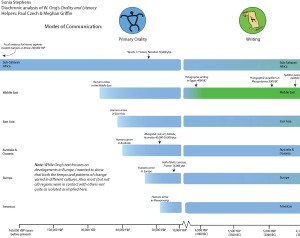I’m jumping from a cognitive science approach to visuals back to a more social & rhetorical approach with this chapter. Like my last two readings, this one provides yet another framework for analyzing scientific visuals, but the approach is pretty different (which is great, because I feel like I really need a break from the framework stuff at the moment.)
Also, I believe this is one of the longest titles in one of my readings…
Luc Pauwels. “A Theoretical Framework for Assessing Visual Representational Practices in Knowledge Building and Science Communications.” in Luc. Pauwels (ed) Visual Cultures of Science: Rethinking Representational Practices in Knowledge Building and Science, pp. 1-25. Hanover: Dartmouth College Press, 2006.
Summary: Pauwels’ aim is to establish a framework for analyzing scientific visualizations that includes: the nature of the referent, type of medium, methodology for creation, and uses of the resulting image. The nature of scientific referents falls on a continuum from material/physical to mental/conceptual: directly observable, visible with tools, non-visual phenomena, explanations of non-visual data trends, postulated phenomena and metaphors. Representations can include multiple types of referents (e.g., photo with arrows for non-visual process), and each representation expresses a reality that shapes the image’s interpretation. Illustrations should be both representative of their subject matter and valid examples of the subject (e.g., a photo of a specific bird vs. a stylized drawing of that species.) Production processes all have intertwined social, technological, and cultural aspects (affordances, conventions, and constraints.) Different referents will have “appropriate” conventions for presentation; conventions also vary with the purpose of the illustration (further analysis, teach concepts, etc.) The upshot is that representations have multiple purposes/motivations and may be interpreted differently (e.g., can be used as boundary objects.)
Comments: Scientific illustrations are less a transparent “window” than a carefully selected and stylized rhetorical presentation (though P. doesn’t use “rhetoric”.) Discusses the need for greater awareness of all aspects of his framework for scientific illustrators (and also public)- e.g., awareness of implications of disciplinary conventions for image format. Physical representations are inherently social objects, unlike mental representations. Visual media have one important constraint- that they depict a specific example, rather than words, which can specify a range (e.g., a specific drawing of a flower vs. “this flower has 6-8 petals”)- the viewer has to decide how significant each element of the illustration is (if they even have the awareness to judge this.) Verbal descriptions or use of conventions can help with this problem.
Links to: Kostelnick & Hassett (conventions & rhetorical uses of images); Gilbert (categories of scientific illustrations)
